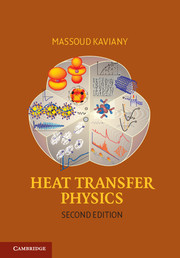Book contents
- Frontmatter
- Dedication
- Contents
- Preface
- Acknowledgments
- 1 Introduction and Preliminaries
- 2 Molecular Orbitals/Potentials/Dynamics and Quantum Energy States
- 3 Carrier Energy Transport and Transformation Theories
- 4 Phonon Energy Storage, Transport, and Transformation Kinetics
- 5 Electron Energy Storage, Transport, and Transformation Kinetics
- 6 Fluid Particle Energy Storage, Transport, and Transformation Kinetics
- 7 Photon Energy Storage, Transport, and Transformation Kinetics
- APPENDIX A Tables of Properties and Universal Constants
- APPENDIX B Derivation of Green–Kubo Relation
- APPENDIX C Derivation of Minimum Phonon Conductivity Relations
- APPENDIX D Derivation of Phonon Boundary Resistance
- APPENDIX E Derivation of Fermi Golden Rule
- APPENDIX F Derivation of Equilibrium, Particle Probability Distribution Functions
- APPENDIX G Phonon Contributions to the Seebeck Coefficient
- APPENDIX H Monte Carlo Method for Carrier Transport
- APPENDIX I Ladder Operators
- Nomenclature
- Abbreviations
- Glossary
- References
- Index
Preface
Published online by Cambridge University Press: 05 June 2014
- Frontmatter
- Dedication
- Contents
- Preface
- Acknowledgments
- 1 Introduction and Preliminaries
- 2 Molecular Orbitals/Potentials/Dynamics and Quantum Energy States
- 3 Carrier Energy Transport and Transformation Theories
- 4 Phonon Energy Storage, Transport, and Transformation Kinetics
- 5 Electron Energy Storage, Transport, and Transformation Kinetics
- 6 Fluid Particle Energy Storage, Transport, and Transformation Kinetics
- 7 Photon Energy Storage, Transport, and Transformation Kinetics
- APPENDIX A Tables of Properties and Universal Constants
- APPENDIX B Derivation of Green–Kubo Relation
- APPENDIX C Derivation of Minimum Phonon Conductivity Relations
- APPENDIX D Derivation of Phonon Boundary Resistance
- APPENDIX E Derivation of Fermi Golden Rule
- APPENDIX F Derivation of Equilibrium, Particle Probability Distribution Functions
- APPENDIX G Phonon Contributions to the Seebeck Coefficient
- APPENDIX H Monte Carlo Method for Carrier Transport
- APPENDIX I Ladder Operators
- Nomenclature
- Abbreviations
- Glossary
- References
- Index
Summary
Heat is atomic motion of matter, and temperature indicates the equilibrium distribution of this motion. Nonequilibrium atomic motions, created for example by a temperature gradient, result in heat transfer. Heat transfer physics describes the thermodynamics and kinetics (mechanisms and rates) of energy storage, transport, and transformation by means of principal energy carriers. Heat is energy that is stored in the temperature-dependent motion and within the various particles that make up all matter in all of its phases, including electrons, atomic nuclei, individual atoms, and molecules. Heat can be transferred to and from matter by one or more of the principal energy carriers: electrons (either as classical or quantum entities), fluid particles (classical particles or quantum particles), phonons (lattice-vibration quantum waves, i.e., quasi-particles), and photons (quantum particles). The state of the energy stored within matter or transported by the carriers can be described by a combination of classical and quantum statistical mechanics. The energy is also transformed (converted) between the various carriers. All processes that act on this energy are ultimately governed by the rates at which various physical phenomena occur, such as the rate of particle collisions in classical mechanics. It is the combination of these various processes (and their governing rates) within a particular system that determines the overall system behavior, such as the net rate of energy storage or transport. Controlling every process, from the atomic level (studied here) to the macroscale (covered in an introductory heat transfer course), are the laws of thermodynamics, including conservation of energy.
- Type
- Chapter
- Information
- Heat Transfer Physics , pp. xvii - xxPublisher: Cambridge University PressPrint publication year: 2014



